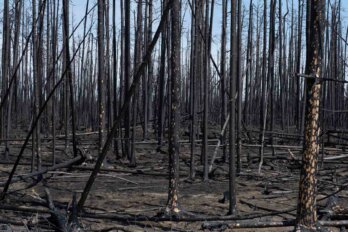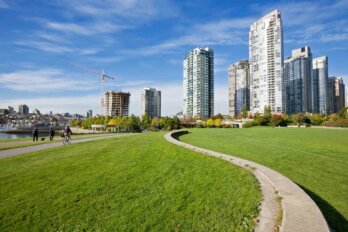In late January 2014, the bypass gate in one of Hamilton’s nine overflow tanks, designed to capture the city’s residential and commercial wastewater until it can be treated, was left open. Sewage began quietly leaking out of a fifteen-centimetre gap into Chedoke Creek, which, about a kilometre downstream, empties into an enormous body of placid water called Cootes Paradise.
At first glance, Cootes Paradise is exactly that—more than six square kilometres of lake and marshland, oak and white pine forests, all teeming with herons, cormorants, and turtles. Cootes Paradise is home to hundreds of species of plant and animal, some of them—like the wood thrush—endangered or on the verge of becoming so. The area holds many grandiose-sounding designations: federally, it is a National Historic Site, an Important Bird Area, and an Important Reptile and Amphibian Area; provincially, it’s an Area of Natural and Scientific Interest, an Environmentally Sensitive Area, and a Provincially Significant Wetland. Named after Thomas Coote, a British captain who hunted waterfowl there during the American Revolutionary War, Cootes Paradise today is part of the Royal Botanical Gardens, which were formally established, in 1941, to protect and manage the area. It is a rare urban marshland on the shores of Lake Ontario, into which the water of Cootes Paradise flows.
In summer, kayaks and canoes slip across its surface; in winter, the shallow water often freezes solid, creating an enormous outdoor public skating rink. But underneath these idyllic scenes is tainted water, thick with human feces and raw sewage. And that messy reality is far from an exception: as recently as 2017, Canada’s municipalities were dumping more than 270 million cubic metres of untreated wastewater, or roughly 75,000 seriously fouled Olympic-sized pools, directly into rivers and oceans. Much of it goes unnoticed. The 2014 leak in Hamilton went undetected for years and allowed “combined sewage”—untreated wastewater mixed with stormwater runoff—to foul Chedoke Creek and Cootes Paradise. The story is a depressingly apt illustration of the struggle many older urban centres face in dealing with their effluent and of our tendency to treat bodies of water like naturally occurring toilets.
Entered from the northeast, via the Queen Elizabeth Way, Hamilton looks apocalyptic: nothing but warehouses, factories, massive slag heaps, and smokestacks. Some stacks spit pillars of actual flame. This is where companies with historic names like Stelco and Dofasco gave Ontario’s third-largest city the nickname Steeltown. Driving into the city’s west end, via Highway 403, however, offers a surprisingly sylvan view of Cootes Paradise on one side and Hamilton Harbour on the other. “If you know us from the QEW, we’re Mordor,” says Jason Allen, host of the Hamilton-based radio show The Environmental Urbanist. “If you know us from the 403, we’re Rivendell.”
As a frequent visitor to Cootes Paradise, Allen saw the increasingly awful state of the water and the mess that was washing up on shore—including tampon applicators, condoms, and hypodermic needles. He wasn’t the only one: in late 2015, an Anishinaabe activist named Kristen Villebrun and her friend Wendy Bush spent three days on a floating raft in Hamilton Harbour to draw attention to the city’s neglect of its water and shoreline. In 2018, John Boddy, a Hamilton resident who often cycled the waterfront, submitted a complaint to Ontario’s Ministry of the Environment, Conservation and Parks (MECP) about the state of the water, prompting an official inspection by the province.
Chris McLaughlin, the executive director of Hamilton’s Bay Area Restoration Council and a member of the International Joint Commission’s Great Lakes Water Quality Board, recalls Cootes Paradise and Chedoke Creek, by the summer of 2018, as a “barnyard.” Water samples taken at that time, he says, showed E. coli levels that were higher than average “by an order of magnitude.” McLaughlin remembers taking a boat out into Cootes to collect samples with Tys Theysmeyer, the Royal Botanical Gardens’ head of natural lands. “It was the most disgusting thing,” McLaughlin says. “It was overwhelming. I remember saying, Oh my God, turn us around, turn us around!”
Somehow—possibly due to a computer error—the leak at the bypass gate went undetected until July 2018. In that astonishing span of four and a half years, more than 24 billion litres of untreated wastewater leaked out. In 2019, the Hamilton Spectator noted that this amount is equivalent to 10,000 Olympic-sized pools—around an eighth of what the entire country’s cities dump untreated. The newspaper also revealed how the city had buried an internal report on the extent and duration of the spill. Hamilton’s most recent municipal election was held in October 2018, before the report was made public, so no elected officials have paid a price yet, though two senior city managers who were tasked with managing the spill and its fallout, general manager of public works Dan McKinnon and director of water Andrew Grice, left their jobs in September 2021.
Locally, the episode is known as “Sewergate”—the rare -gate scandal that involves an actual gate. The Ontario MECP charged the city with two violations and demanded it clean the mess up. Cost estimates for dredging the worst-hit parts of Chedoke Creek are around $6 million, though plans to fix some of the longer-term and more widespread damage caused by the spill could cost the city more than $100 million and take decades to complete.
One irony of the disaster is that the immediate source of the problem, a combined sewer overflow (CSO) tank—a massive underground wastewater-storage facility—has been part of the city’s solution for keeping most wastewater out of creeks and harbours. Like most older Canadian cities, Hamilton is primarily serviced by a combined sewer system, into which flows whatever residents and businesses flush or pour down their drains, plus whatever runs into outdoor sewer grates when it rains or when the snow melts. (In newer municipalities and newer parts of Hamilton, those systems are separated.) All of that water has to be treated before it can be released into the wild, and in the event of an unusually intense storm—something that has become far less unusual and far more intense due to climate change—a combined system can become overloaded. Between 1989 and 2010, Hamilton built nine CSO facilities in various parts of the city. Above ground, HCS04, the CSO tank that was the site of the Sewergate spill, is nothing more than a small windowless shed. But, below ground, it’s a tank that can hold 77,000 cubic metres of excess wastewater and stormwater, for days if necessary, before sending it on to the Woodward Wastewater Treatment Plant. Other Canadian cities use similar facilities—Ottawa and Toronto have built or are building massive storage tunnels that will serve the same purpose.
CSO tanks are the equivalent of putting a large bucket under a leaky roof in a rainstorm—not ideal, but better than doing nothing. Until 2015, St. John’s was dumping all of its wastewater directly into the harbour via century-old pipes. The city has since upgraded its primary treatment plant, but even so, those are designed to remove only solid waste from water—basically anything that floats or sinks. Even when the damage is not as visible as needles and feces, chemicals in wastewater can kill local fish populations and destroy plant life, not to mention making the water unsuitable to swim in or drink.
Large-scale storage facilities have the same inherent flaw as buckets used to catch dripping rain: if there is too much water at once, either it spills out or you have to let some of it go before it can be dealt with. The storm that hit BC last November caused weeks-long failures in multiple sewer systems; in smaller cities, such as Merritt, streets were flooded with raw sewage. More and more often, nature is sending down too much water for our systems to handle.
The City of Hamilton now posts public data on overflows at its various storage and treatment sites. Cari Vanderperk, Hamilton’s new director of watershed management, says the public data is part of a larger effort by the city to be more open and transparent. For one thing, the overflow gate inside HCS04 is now watched at all hours by CCTV cameras. Which isn’t to say the system works perfectly: in October 2021, for example, heavy rainfall forced Hamilton to dump many millions of litres of dirty water into Red Hill Creek, in the city’s southeast. Nor has the city necessarily learned its lesson when it comes to dealing with wastewater. As recently as last fall, city council was contemplating a plan to solve the issue of flooded basements in one wealthy suburb by building an overflow sewage pipe that would flow directly into Ancaster Creek, another of Cootes Paradise’s many tributaries—potentially adding to the very problem Hamilton was already spending millions to fix. It’s also worth noting that the original plan to deal with the mess in Chedoke Creek and Cootes Paradise was to simply leave it there. The city argued that the area had been fairly polluted even before the leak and that dredging up all that muck might make things worse. The province, to its credit, told the city to try again. Still, the provincial government isn’t entirely off the hook: a November 2021 report from Ontario’s auditor general referenced the spill, noting that “neither the Environment Ministry nor the City of Hamilton informed the public about its magnitude.”
Mclaughlin, of Hamilton’s Bay Area Restoration Council, is quick to separate Sewergate the political scandal from what he sees as the more fundamental problem, which is urban dwellers’ disconnected relationship with water. Understanding the extent to which we are entangled with water can be as simple as knowing the geography: McLaughlin notes that the watershed that feeds into Cootes Paradise stretches over approximately 300 square kilometres. It becomes harder to see natural bodies of water as resources we are free to dump our messes into when we realize they are all around us.
Zobia Jawed, an assistant professor in McMaster University’s faculty of engineering, notes that the kinds of policy decisions, infrastructural failures, and generally bad behaviour that led to the fouling of Cootes Paradise stretch well beyond the bounds of its watershed. “This is not just a Hamilton problem,” she says. “This is a problem that probably exists across Canada—anywhere we have a wastewater system.” Jawed, who studies wastewater treatment and environmental sustainability, insists that we need to break away from the model of simply treating dirty water and then dumping it. She cites the example of California, which currently recycles 10 percent of its wastewater.
Beyond the massive funding required to even contemplate a project like that in Canada, we need a change of perception. Jawed points out that people tend to be more vocal about the state of the water coming into their house than about the stuff flowing out of it—and, with an estimated half a million Canadian homes still serviced by lead pipes, even the problems with the water coming in tend to be invisible. “When you give people a glass of water, they’re more worried about having clean, clear, odourless water to drink—they don’t care about all of the other things they are unable to see that could be potentially more detrimental to human health,” Jawed says. “The same goes with large water bodies.” Until our nature walks and bike rides and kayak trips are ruined by the sight and smell of raw sewage, we figure everything is fine. If our lakes and rivers look okay, we think, they can always take a little more abuse.
Correction March 7, 2022: An earlier version of this piece stated that Zobia Jawed is a professor at McMaster University. In fact, she is an assistant professor. The Walrus regrets the error.




